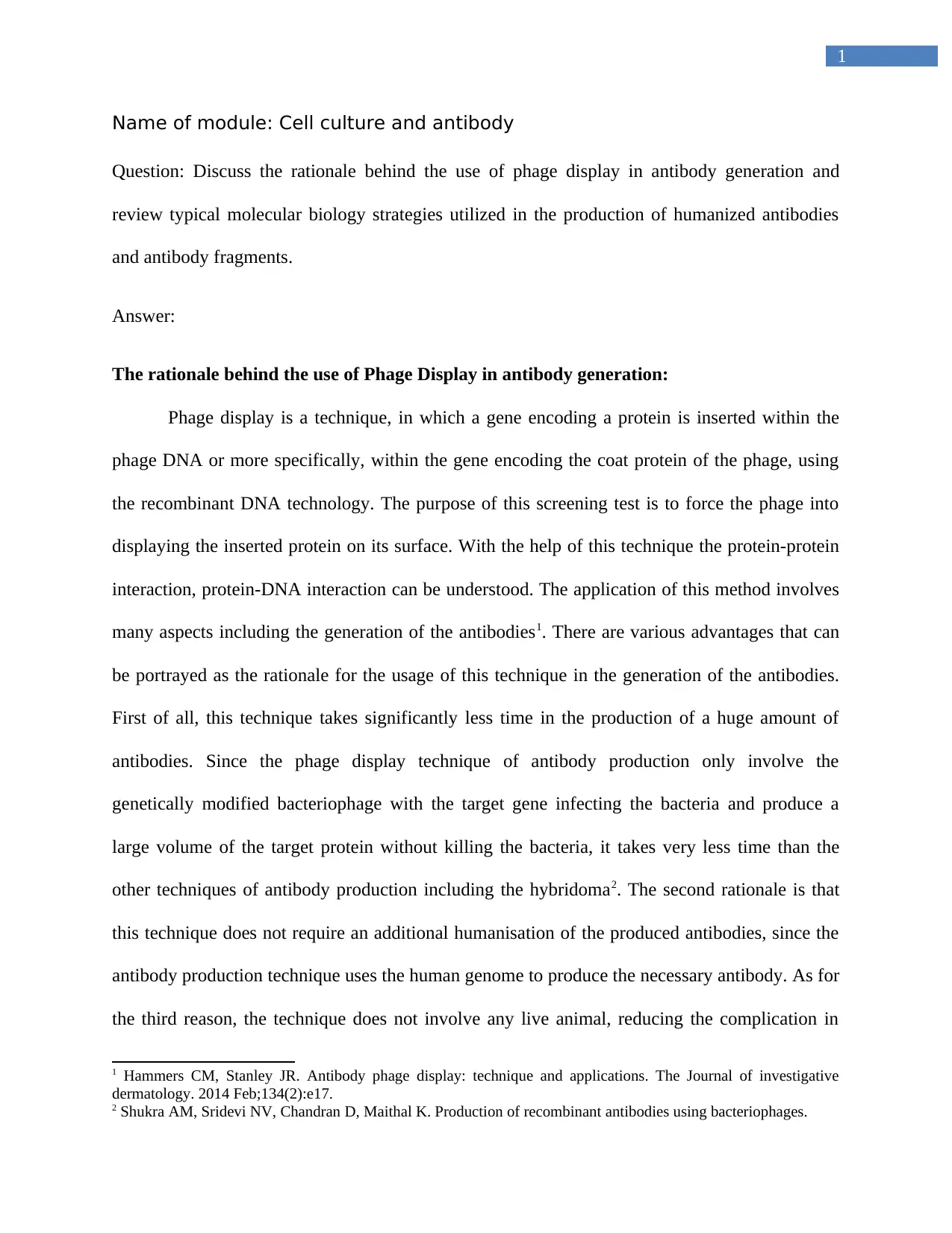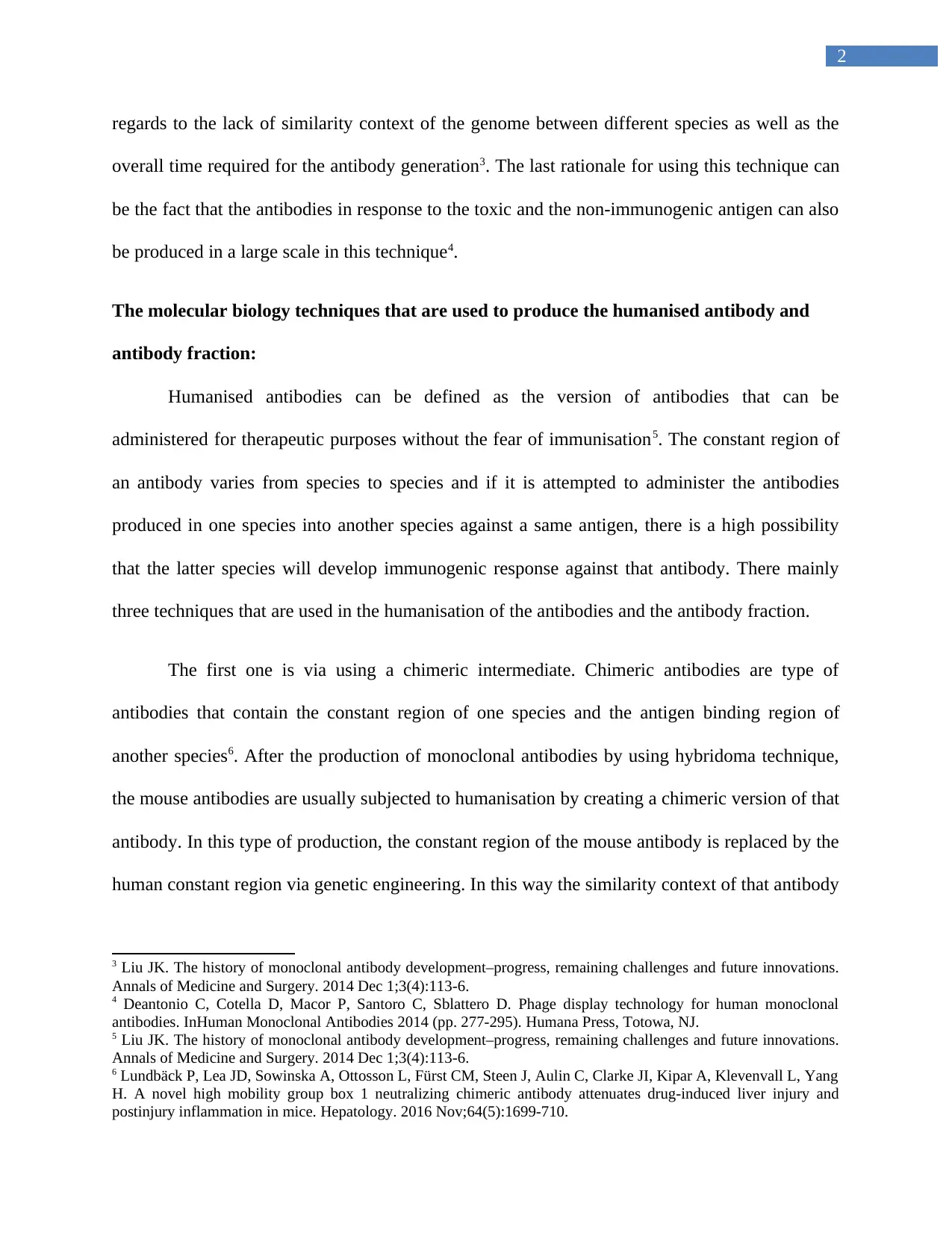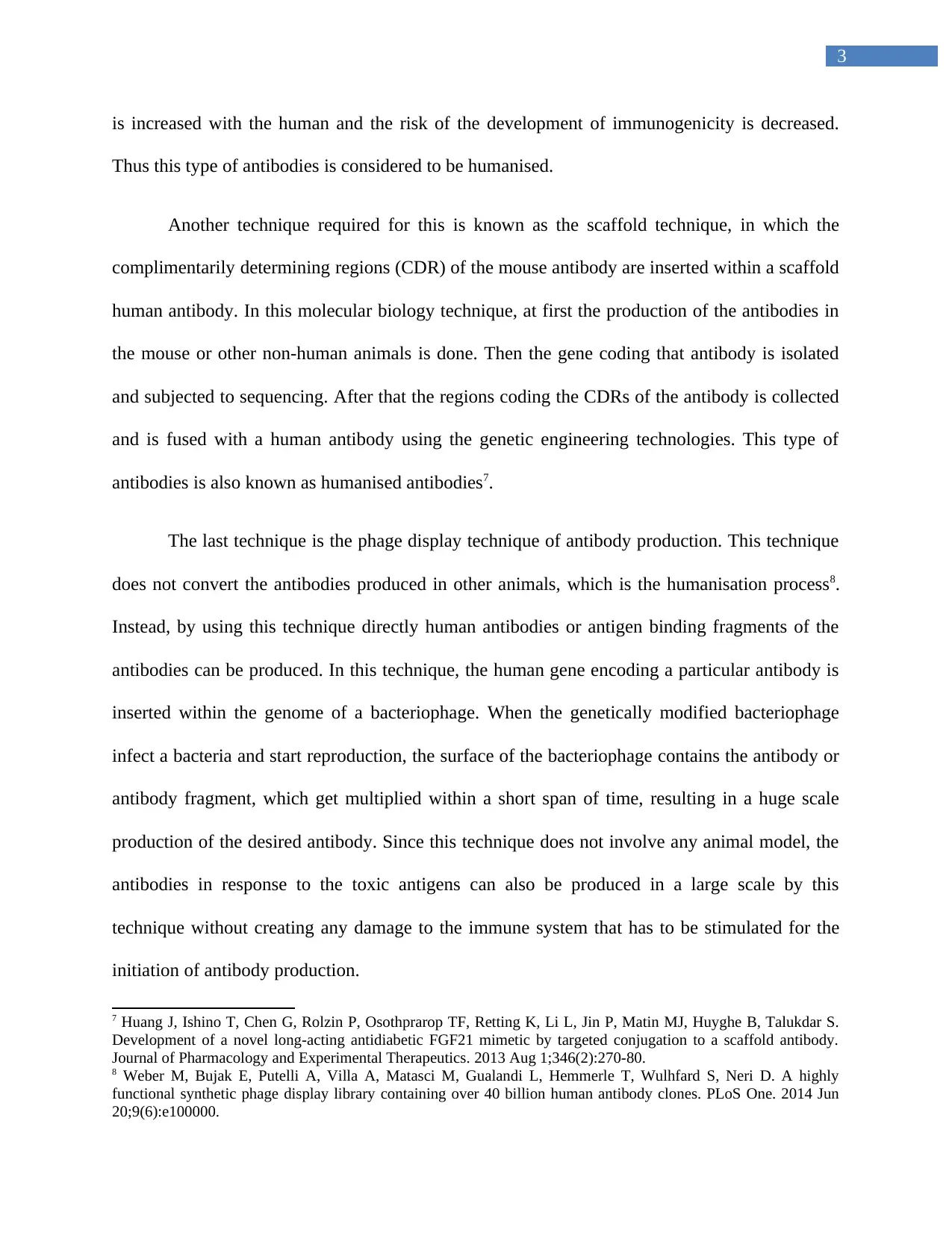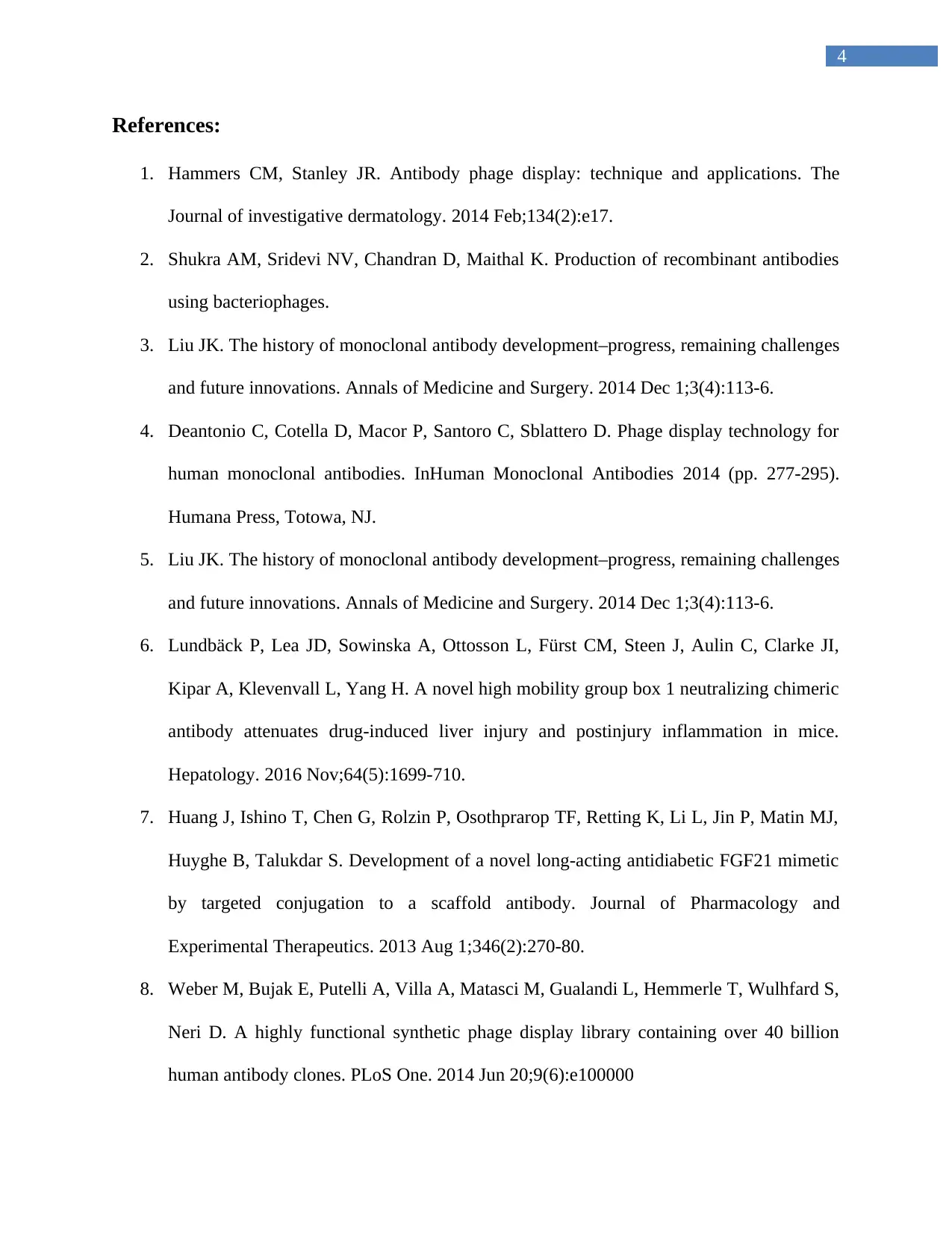Molecular Biology Strategies in Antibody Humanization: Analysis
VerifiedAdded on 2022/09/01
|5
|1195
|17
Homework Assignment
AI Summary
This assignment delves into the rationale behind the use of phage display in antibody generation, highlighting its advantages such as rapid antibody production, the absence of a need for antibody humanization, the avoidance of animal models, and the ability to produce antibodies against toxic antigens. The assignment then reviews the molecular biology techniques employed in the production of humanized antibodies and antibody fragments, including chimeric antibodies, scaffold techniques involving complementarity determining regions (CDRs), and the phage display technique itself. The discussion emphasizes the benefits of humanized antibodies in therapeutic applications and the detailed processes involved in each technique. The assignment provides a comprehensive overview of the key methods in antibody engineering and production.

Name of the Student:
Name of the University:
Author Note:
Name of the University:
Author Note:
Paraphrase This Document
Need a fresh take? Get an instant paraphrase of this document with our AI Paraphraser

1
Name of module: Cell culture and antibody
Question: Discuss the rationale behind the use of phage display in antibody generation and
review typical molecular biology strategies utilized in the production of humanized antibodies
and antibody fragments.
Answer:
The rationale behind the use of Phage Display in antibody generation:
Phage display is a technique, in which a gene encoding a protein is inserted within the
phage DNA or more specifically, within the gene encoding the coat protein of the phage, using
the recombinant DNA technology. The purpose of this screening test is to force the phage into
displaying the inserted protein on its surface. With the help of this technique the protein-protein
interaction, protein-DNA interaction can be understood. The application of this method involves
many aspects including the generation of the antibodies1. There are various advantages that can
be portrayed as the rationale for the usage of this technique in the generation of the antibodies.
First of all, this technique takes significantly less time in the production of a huge amount of
antibodies. Since the phage display technique of antibody production only involve the
genetically modified bacteriophage with the target gene infecting the bacteria and produce a
large volume of the target protein without killing the bacteria, it takes very less time than the
other techniques of antibody production including the hybridoma2. The second rationale is that
this technique does not require an additional humanisation of the produced antibodies, since the
antibody production technique uses the human genome to produce the necessary antibody. As for
the third reason, the technique does not involve any live animal, reducing the complication in
1 Hammers CM, Stanley JR. Antibody phage display: technique and applications. The Journal of investigative
dermatology. 2014 Feb;134(2):e17.
2 Shukra AM, Sridevi NV, Chandran D, Maithal K. Production of recombinant antibodies using bacteriophages.
Name of module: Cell culture and antibody
Question: Discuss the rationale behind the use of phage display in antibody generation and
review typical molecular biology strategies utilized in the production of humanized antibodies
and antibody fragments.
Answer:
The rationale behind the use of Phage Display in antibody generation:
Phage display is a technique, in which a gene encoding a protein is inserted within the
phage DNA or more specifically, within the gene encoding the coat protein of the phage, using
the recombinant DNA technology. The purpose of this screening test is to force the phage into
displaying the inserted protein on its surface. With the help of this technique the protein-protein
interaction, protein-DNA interaction can be understood. The application of this method involves
many aspects including the generation of the antibodies1. There are various advantages that can
be portrayed as the rationale for the usage of this technique in the generation of the antibodies.
First of all, this technique takes significantly less time in the production of a huge amount of
antibodies. Since the phage display technique of antibody production only involve the
genetically modified bacteriophage with the target gene infecting the bacteria and produce a
large volume of the target protein without killing the bacteria, it takes very less time than the
other techniques of antibody production including the hybridoma2. The second rationale is that
this technique does not require an additional humanisation of the produced antibodies, since the
antibody production technique uses the human genome to produce the necessary antibody. As for
the third reason, the technique does not involve any live animal, reducing the complication in
1 Hammers CM, Stanley JR. Antibody phage display: technique and applications. The Journal of investigative
dermatology. 2014 Feb;134(2):e17.
2 Shukra AM, Sridevi NV, Chandran D, Maithal K. Production of recombinant antibodies using bacteriophages.

2
regards to the lack of similarity context of the genome between different species as well as the
overall time required for the antibody generation3. The last rationale for using this technique can
be the fact that the antibodies in response to the toxic and the non-immunogenic antigen can also
be produced in a large scale in this technique4.
The molecular biology techniques that are used to produce the humanised antibody and
antibody fraction:
Humanised antibodies can be defined as the version of antibodies that can be
administered for therapeutic purposes without the fear of immunisation5. The constant region of
an antibody varies from species to species and if it is attempted to administer the antibodies
produced in one species into another species against a same antigen, there is a high possibility
that the latter species will develop immunogenic response against that antibody. There mainly
three techniques that are used in the humanisation of the antibodies and the antibody fraction.
The first one is via using a chimeric intermediate. Chimeric antibodies are type of
antibodies that contain the constant region of one species and the antigen binding region of
another species6. After the production of monoclonal antibodies by using hybridoma technique,
the mouse antibodies are usually subjected to humanisation by creating a chimeric version of that
antibody. In this type of production, the constant region of the mouse antibody is replaced by the
human constant region via genetic engineering. In this way the similarity context of that antibody
3 Liu JK. The history of monoclonal antibody development–progress, remaining challenges and future innovations.
Annals of Medicine and Surgery. 2014 Dec 1;3(4):113-6.
4 Deantonio C, Cotella D, Macor P, Santoro C, Sblattero D. Phage display technology for human monoclonal
antibodies. InHuman Monoclonal Antibodies 2014 (pp. 277-295). Humana Press, Totowa, NJ.
5 Liu JK. The history of monoclonal antibody development–progress, remaining challenges and future innovations.
Annals of Medicine and Surgery. 2014 Dec 1;3(4):113-6.
6 Lundbäck P, Lea JD, Sowinska A, Ottosson L, Fürst CM, Steen J, Aulin C, Clarke JI, Kipar A, Klevenvall L, Yang
H. A novel high mobility group box 1 neutralizing chimeric antibody attenuates drug‐induced liver injury and
postinjury inflammation in mice. Hepatology. 2016 Nov;64(5):1699-710.
regards to the lack of similarity context of the genome between different species as well as the
overall time required for the antibody generation3. The last rationale for using this technique can
be the fact that the antibodies in response to the toxic and the non-immunogenic antigen can also
be produced in a large scale in this technique4.
The molecular biology techniques that are used to produce the humanised antibody and
antibody fraction:
Humanised antibodies can be defined as the version of antibodies that can be
administered for therapeutic purposes without the fear of immunisation5. The constant region of
an antibody varies from species to species and if it is attempted to administer the antibodies
produced in one species into another species against a same antigen, there is a high possibility
that the latter species will develop immunogenic response against that antibody. There mainly
three techniques that are used in the humanisation of the antibodies and the antibody fraction.
The first one is via using a chimeric intermediate. Chimeric antibodies are type of
antibodies that contain the constant region of one species and the antigen binding region of
another species6. After the production of monoclonal antibodies by using hybridoma technique,
the mouse antibodies are usually subjected to humanisation by creating a chimeric version of that
antibody. In this type of production, the constant region of the mouse antibody is replaced by the
human constant region via genetic engineering. In this way the similarity context of that antibody
3 Liu JK. The history of monoclonal antibody development–progress, remaining challenges and future innovations.
Annals of Medicine and Surgery. 2014 Dec 1;3(4):113-6.
4 Deantonio C, Cotella D, Macor P, Santoro C, Sblattero D. Phage display technology for human monoclonal
antibodies. InHuman Monoclonal Antibodies 2014 (pp. 277-295). Humana Press, Totowa, NJ.
5 Liu JK. The history of monoclonal antibody development–progress, remaining challenges and future innovations.
Annals of Medicine and Surgery. 2014 Dec 1;3(4):113-6.
6 Lundbäck P, Lea JD, Sowinska A, Ottosson L, Fürst CM, Steen J, Aulin C, Clarke JI, Kipar A, Klevenvall L, Yang
H. A novel high mobility group box 1 neutralizing chimeric antibody attenuates drug‐induced liver injury and
postinjury inflammation in mice. Hepatology. 2016 Nov;64(5):1699-710.
⊘ This is a preview!⊘
Do you want full access?
Subscribe today to unlock all pages.

Trusted by 1+ million students worldwide

3
is increased with the human and the risk of the development of immunogenicity is decreased.
Thus this type of antibodies is considered to be humanised.
Another technique required for this is known as the scaffold technique, in which the
complimentarily determining regions (CDR) of the mouse antibody are inserted within a scaffold
human antibody. In this molecular biology technique, at first the production of the antibodies in
the mouse or other non-human animals is done. Then the gene coding that antibody is isolated
and subjected to sequencing. After that the regions coding the CDRs of the antibody is collected
and is fused with a human antibody using the genetic engineering technologies. This type of
antibodies is also known as humanised antibodies7.
The last technique is the phage display technique of antibody production. This technique
does not convert the antibodies produced in other animals, which is the humanisation process8.
Instead, by using this technique directly human antibodies or antigen binding fragments of the
antibodies can be produced. In this technique, the human gene encoding a particular antibody is
inserted within the genome of a bacteriophage. When the genetically modified bacteriophage
infect a bacteria and start reproduction, the surface of the bacteriophage contains the antibody or
antibody fragment, which get multiplied within a short span of time, resulting in a huge scale
production of the desired antibody. Since this technique does not involve any animal model, the
antibodies in response to the toxic antigens can also be produced in a large scale by this
technique without creating any damage to the immune system that has to be stimulated for the
initiation of antibody production.
7 Huang J, Ishino T, Chen G, Rolzin P, Osothprarop TF, Retting K, Li L, Jin P, Matin MJ, Huyghe B, Talukdar S.
Development of a novel long-acting antidiabetic FGF21 mimetic by targeted conjugation to a scaffold antibody.
Journal of Pharmacology and Experimental Therapeutics. 2013 Aug 1;346(2):270-80.
8 Weber M, Bujak E, Putelli A, Villa A, Matasci M, Gualandi L, Hemmerle T, Wulhfard S, Neri D. A highly
functional synthetic phage display library containing over 40 billion human antibody clones. PLoS One. 2014 Jun
20;9(6):e100000.
is increased with the human and the risk of the development of immunogenicity is decreased.
Thus this type of antibodies is considered to be humanised.
Another technique required for this is known as the scaffold technique, in which the
complimentarily determining regions (CDR) of the mouse antibody are inserted within a scaffold
human antibody. In this molecular biology technique, at first the production of the antibodies in
the mouse or other non-human animals is done. Then the gene coding that antibody is isolated
and subjected to sequencing. After that the regions coding the CDRs of the antibody is collected
and is fused with a human antibody using the genetic engineering technologies. This type of
antibodies is also known as humanised antibodies7.
The last technique is the phage display technique of antibody production. This technique
does not convert the antibodies produced in other animals, which is the humanisation process8.
Instead, by using this technique directly human antibodies or antigen binding fragments of the
antibodies can be produced. In this technique, the human gene encoding a particular antibody is
inserted within the genome of a bacteriophage. When the genetically modified bacteriophage
infect a bacteria and start reproduction, the surface of the bacteriophage contains the antibody or
antibody fragment, which get multiplied within a short span of time, resulting in a huge scale
production of the desired antibody. Since this technique does not involve any animal model, the
antibodies in response to the toxic antigens can also be produced in a large scale by this
technique without creating any damage to the immune system that has to be stimulated for the
initiation of antibody production.
7 Huang J, Ishino T, Chen G, Rolzin P, Osothprarop TF, Retting K, Li L, Jin P, Matin MJ, Huyghe B, Talukdar S.
Development of a novel long-acting antidiabetic FGF21 mimetic by targeted conjugation to a scaffold antibody.
Journal of Pharmacology and Experimental Therapeutics. 2013 Aug 1;346(2):270-80.
8 Weber M, Bujak E, Putelli A, Villa A, Matasci M, Gualandi L, Hemmerle T, Wulhfard S, Neri D. A highly
functional synthetic phage display library containing over 40 billion human antibody clones. PLoS One. 2014 Jun
20;9(6):e100000.
Paraphrase This Document
Need a fresh take? Get an instant paraphrase of this document with our AI Paraphraser

4
References:
1. Hammers CM, Stanley JR. Antibody phage display: technique and applications. The
Journal of investigative dermatology. 2014 Feb;134(2):e17.
2. Shukra AM, Sridevi NV, Chandran D, Maithal K. Production of recombinant antibodies
using bacteriophages.
3. Liu JK. The history of monoclonal antibody development–progress, remaining challenges
and future innovations. Annals of Medicine and Surgery. 2014 Dec 1;3(4):113-6.
4. Deantonio C, Cotella D, Macor P, Santoro C, Sblattero D. Phage display technology for
human monoclonal antibodies. InHuman Monoclonal Antibodies 2014 (pp. 277-295).
Humana Press, Totowa, NJ.
5. Liu JK. The history of monoclonal antibody development–progress, remaining challenges
and future innovations. Annals of Medicine and Surgery. 2014 Dec 1;3(4):113-6.
6. Lundbäck P, Lea JD, Sowinska A, Ottosson L, Fürst CM, Steen J, Aulin C, Clarke JI,
Kipar A, Klevenvall L, Yang H. A novel high mobility group box 1 neutralizing chimeric
antibody attenuates drug‐induced liver injury and postinjury inflammation in mice.
Hepatology. 2016 Nov;64(5):1699-710.
7. Huang J, Ishino T, Chen G, Rolzin P, Osothprarop TF, Retting K, Li L, Jin P, Matin MJ,
Huyghe B, Talukdar S. Development of a novel long-acting antidiabetic FGF21 mimetic
by targeted conjugation to a scaffold antibody. Journal of Pharmacology and
Experimental Therapeutics. 2013 Aug 1;346(2):270-80.
8. Weber M, Bujak E, Putelli A, Villa A, Matasci M, Gualandi L, Hemmerle T, Wulhfard S,
Neri D. A highly functional synthetic phage display library containing over 40 billion
human antibody clones. PLoS One. 2014 Jun 20;9(6):e100000
References:
1. Hammers CM, Stanley JR. Antibody phage display: technique and applications. The
Journal of investigative dermatology. 2014 Feb;134(2):e17.
2. Shukra AM, Sridevi NV, Chandran D, Maithal K. Production of recombinant antibodies
using bacteriophages.
3. Liu JK. The history of monoclonal antibody development–progress, remaining challenges
and future innovations. Annals of Medicine and Surgery. 2014 Dec 1;3(4):113-6.
4. Deantonio C, Cotella D, Macor P, Santoro C, Sblattero D. Phage display technology for
human monoclonal antibodies. InHuman Monoclonal Antibodies 2014 (pp. 277-295).
Humana Press, Totowa, NJ.
5. Liu JK. The history of monoclonal antibody development–progress, remaining challenges
and future innovations. Annals of Medicine and Surgery. 2014 Dec 1;3(4):113-6.
6. Lundbäck P, Lea JD, Sowinska A, Ottosson L, Fürst CM, Steen J, Aulin C, Clarke JI,
Kipar A, Klevenvall L, Yang H. A novel high mobility group box 1 neutralizing chimeric
antibody attenuates drug‐induced liver injury and postinjury inflammation in mice.
Hepatology. 2016 Nov;64(5):1699-710.
7. Huang J, Ishino T, Chen G, Rolzin P, Osothprarop TF, Retting K, Li L, Jin P, Matin MJ,
Huyghe B, Talukdar S. Development of a novel long-acting antidiabetic FGF21 mimetic
by targeted conjugation to a scaffold antibody. Journal of Pharmacology and
Experimental Therapeutics. 2013 Aug 1;346(2):270-80.
8. Weber M, Bujak E, Putelli A, Villa A, Matasci M, Gualandi L, Hemmerle T, Wulhfard S,
Neri D. A highly functional synthetic phage display library containing over 40 billion
human antibody clones. PLoS One. 2014 Jun 20;9(6):e100000
1 out of 5
Your All-in-One AI-Powered Toolkit for Academic Success.
+13062052269
info@desklib.com
Available 24*7 on WhatsApp / Email
![[object Object]](/_next/static/media/star-bottom.7253800d.svg)
Unlock your academic potential
Copyright © 2020–2025 A2Z Services. All Rights Reserved. Developed and managed by ZUCOL.

